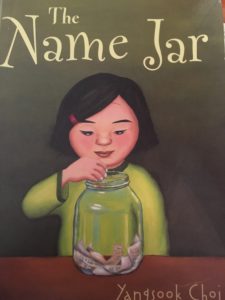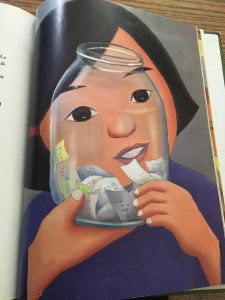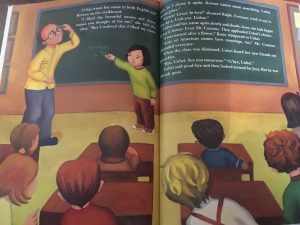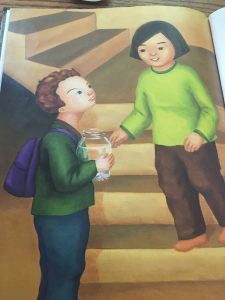Title: The Name Jar

Author: Yangsook Choi
Illustrator: Yangsook Choi
Publisher and Year: Alfred A. Knopf, 2001
Number of Pages: 30
Genre: Realistic Fiction
Analysis: The Name Jar is about a young girl, Unhei, and her family’s adjustment after their move from Korea to America. Once in America, Unhei realizes that her name is different and she decides that she is going to come up with a new name using her classmates’ suggestions in the name jar. At the end of the book, Unhei realizes that she doesn’t feel like herself with any of the American names and decides to keep her Korean name because it makes her unique.
This book can function as a window for people not from Korea. The culture portrayed throughout the book teaches the audience lessons about differences between the American and Korean culture. Another function of this book is a mirror for people who move from Korea to the United States. This book allows Korean children who move to the United States to understand and relate to Unhei and her family.
Perceptually, the front cover leaves the reader with a mysterious feeling and numerous thoughts and questions about the entirety of the book. The ambiguity of the front cover draws the audience in to read more of the book. Once starting to read the book, there is a lot of text per page, which means the author has a lot of information to share. Along with the length of the text, the color of the text was typically black on a white or light background. Occasionally the text was white on a dark background, but either way the text was simple and easy to read.

Structurally, Unhei faces to the right, representing that she is less secure, but after she decides to keep her Korean name she faces towards the left. Unhei’s security within herself could be based off of lack of security after moving to a new country, making new friends, and having a new school. However, once she adjusts and learns that her name is special after all, Unhei has gained security within herself. Throughout most of the book, the images mirror the text further emphasizing what the text is saying in a different way. However a couple times the text adds to the images. Typically the text is added to the images when something is written in Korean. Unhei’s stamp or letter from her grandmother were written in Korean and the reader could not have known what the stamp or letter said without having the text to support the images.

Ideologically, this book portrays important life lessons for school age children. One lesson that is taught to the reader is that individuality helps make one unique and special! This book also demonstrates the meaning and importance of true friendship through Joey and Unhei’s friendship. From the beginning of the book, Joey was friendly to Unhei and wanted to get to know more about her. Joey was such an incredible friend that it was actually he who indirectly showed Unhei how special and important her name truly was.

